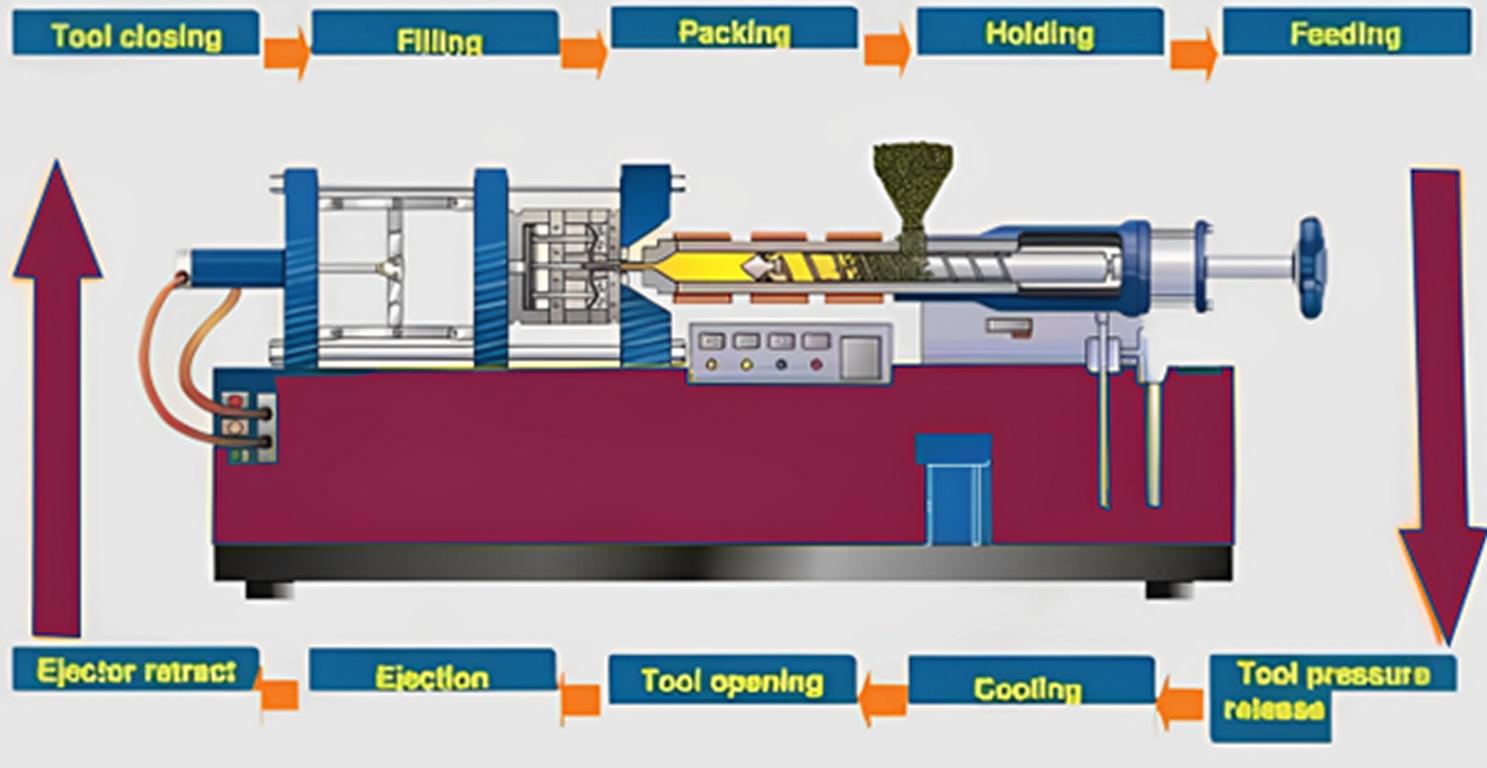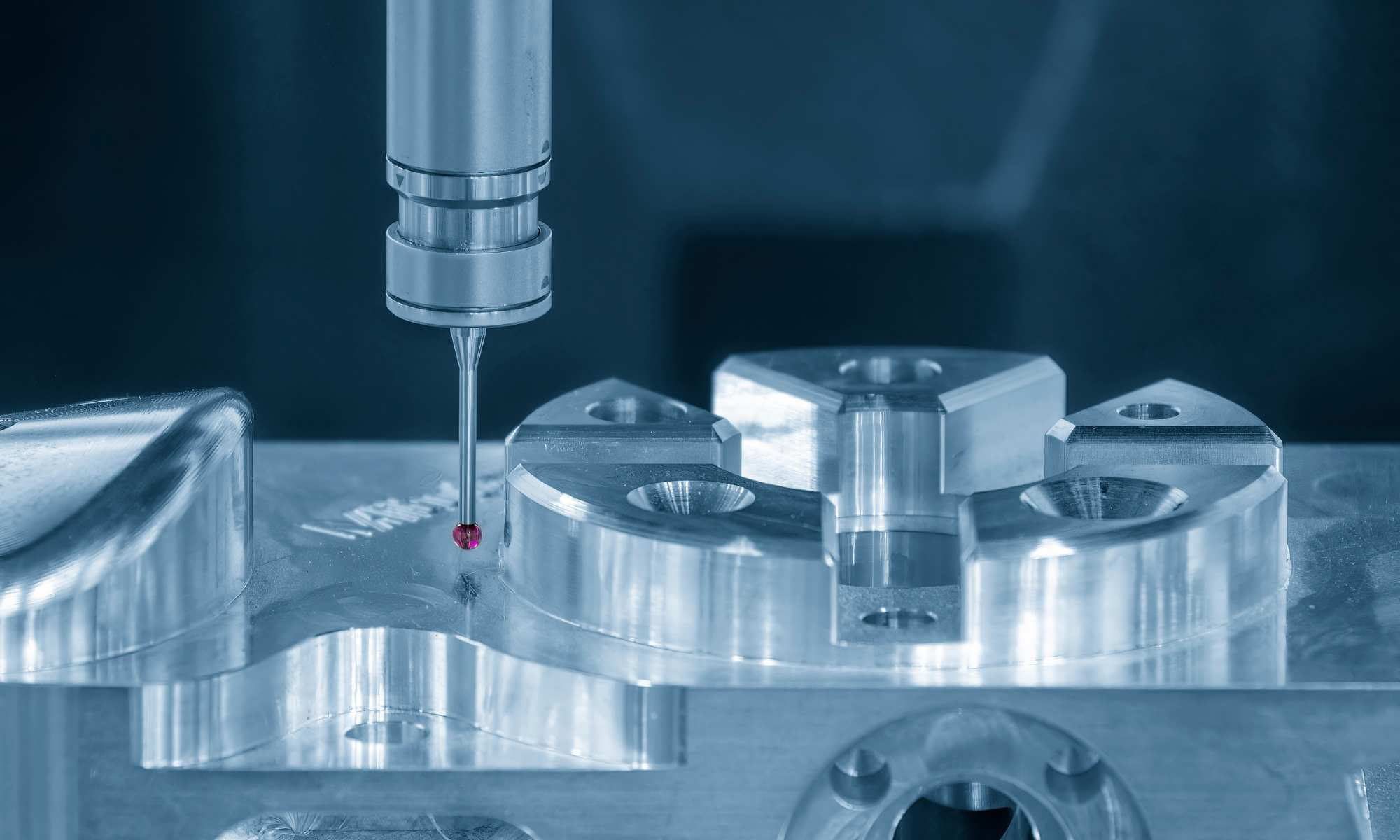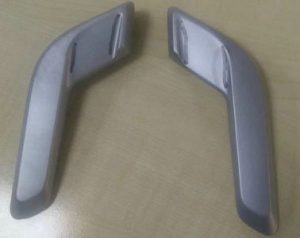What is a Polycarbonate (PC) Injection Molding?
Polycarbonate injection molding is an injection molding part made of PC (polycarbonate) material. It is a manufacturing process to produce products by inserting molten PC (polycarbonate) into a mold. Usually, the melt temperature for PC material is between 270 and 320 degrees Celsius. It may decompose at high temperatures and cause defects like bubbles, black spots, etc. Typically, the injection pressure is controlled between 80 and 120 MPa.
Polycarbonate (PC) is an amorphous thermoplastic. These polymers allow the transmission of light, like glass. An important feature is that they can be heated to their melting point, cooled, and heated again without degrading themselves. As PC can liquify, you can undertake injection molding. They are resistant to heat and can be used with flame-retardant materials. The molding parts are made of polycarbonate, which we call polycarbonate injection molding.

What is Polycarbonates or PC Material
Polycarbonate is generally called PC. Because of its excellent mechanical properties, this is commonly known as bullet-proof plastic. PC injection molding has high mechanical strength, a wide temperature range, good electrical insulation properties (anti-arc performance is unchanged), good dimensional stability and transparency, etc.
It is widely used in electrical products, electric meter enclosures, and electronic product structural members. There are many modified products of PC, usually added with glass fiber, mineral fillers, chemical fire retardants, and other plastics. PC has poor fluidity, and it needs high temperatures when working on the PC injection molding.
Uses of Polycarbonate (PC)
Applications of Polycarbonate injection molding parts
There are many industries that use PC injection molding parts. Below are some of the most the most common industries that use PC injection molding parts:
- Producing a variety of vehicle components, including dashboard panels, interior trim, and headlight lenses, is one of the main uses of PC injection molding. PCs are perfect for these applications because of their excellent impact tolerance.
- Manufacturing a range of electronic components, such as housings for laptops, smartphones, and other electronic devices, is another significant usage for PC injection molding. Because PCs can shield delicate electronic components from heat and fire damage, their heat-resistant and flame-retardant qualities make them perfect for these applications.
- Numerous medical equipment and devices are made using PC injection molding. Syringes, IV connectors, and surgical equipment are among the many items made from polycarbonate. PC is perfect for these applications because of its sterilizability and biocompatibility, which allow it to be utilized in medical settings without running the risk of infection.
- Toys, sporting goods, and home appliances are just a few of the items produced in the consumer goods sector using PC injection molding. Because it is so easily molded into intricate shapes and designs, polycarbonate is a popular material choice for these kinds of applications due to its versatility and aesthetic appeal.
Benefits of Polycarbonate Injection Molding
Versatile. You can be creative with the structures. You can easily shape igloos out of it. Go ahead with those fancy shapes in your mind.
Protects against harmful UV. They keep out the harmful radiation. They do not let the harmful rays into the glasshouses that are made of these materials.
Meager costs. These materials are easy to carry and handle. You do not have to bear high handling costs and labor.
Disadvantages of Polycarbonate injection molding.
Chemical resistance. It is sensitive to chemicals. It deteriorates when exposed to organic solvents. They are very sensitive to abrasive cleaners, cleaning products, and solutions.
Durability. It is prone to absorbing odors and stress cracking.
The Polycarbonate injection molding process
Material processing
Polycarbonate injection molding has high water absorption. So before injection molding, it must be preheated and dried. The pure polycarbonate is dried at 120 °C, and the modified PC should generally be dried for more than 4 hours at a temperature of 110 °C. The drying time should not exceed 10 hours. Generally, you can use the method of air extrusion to determine whether it’s dry enough. The utilization of recycled materials can reach 20%. In some cases, the utilization of recycled materials can be 100%; the actual quantity is subject to the quality requirements of the products. Recycled materials can’t mix different masterbatch simultaneously, or it will seriously damage the nature of the finished product.

PC injection molding
Selection of an injection molding machine
Now, for cost and other reasons, PC often uses modified materials, especially electrical products, which should increase fireproof performance. When the flame-retardant PC and other plastic alloy products are molded, it should make sure the plasticizing system of the injection molding machine mixes well and is corrosion-resistant. It is unachievable for the conventional plasticizing screw. So when choosing, you should state in advance that, usually, there are special PC screws for customers to choose from.
Design of mold and gate for polycarbonate injection molding
The common mold temperature is 80–100 °C, and the temperature of mold adding glass fiber is 100–130 °C. Small products can use the pinpoint gate; the gate depth should be 70% of the thickest part; and other gates are circular and rectangular. If the gate is bigger, it’s better, which can reduce the defects caused by excessive shear. The depth of the vent should be less than 0.03-0.06 mm; the runner should be short and round. The ejection gradient is generally about 30′-1.
Melt temperature for Polycarbonate material
You can use the gas injection method to determine the processing temperature. Generally, the polycarbonate injection molding processing temperature is 270–320 °C. The temperature of the PC with some modification or low molecular weight is 230–270 °C.
Injection speed
When molding, relatively fast injection speeds are usually adopted, such as for electrical switch parts. Commonly, it is from slow to rapid injection molding.
Packing
Packing is 10 bars around; it can be appropriately reduced without the gas lines and color mixing.
Dwell time
If the materials stay at high temperatures for a long time, they will degrade, emit CO2, and turn yellow. You should use PS to clean the cylinder, not LDPE, POM, ABS, or PA.
Special notes
Some modified PC injection molding material, as being recycled many times (the molecular weight decreased) or an uneven mix of ingredients, would easily produce the dark brown liquid bubble.
Produce high-quality polycarbonate injection molding parts that need a special injection barrel because polycarbonate has a high density. Nominal injection barrels make it hard to mold polycarbonate materials. If you are looking for high-quality polycarbonate injection molding parts, you need to look for a professional polycarbonate molding company to support you. You could contact us to make your PC molding parts.

The key point to select injection molding machine for PC Plastic Injection molding parts
Clamping force:
The finished projected area per square centimeter is multiplied by 0.47 to 0.78 tons (or per square inch by 3 to 5 tons).
The size of the machine: A finished weight is approximately 40–60% of the capacity of the injection molding machine. If the machine puts polystyrene as the capacity (oz), which needs to be decreased by 10%, At the beginning, which is used as GUANG DA’s capacity, 1 ounce is 28.3 grams.
Screw: Screw length should be at least 15 diameters long; L/DD of 20:1 is the best. The compression ratio is preferably between 1.5:1 and 30:1. The stop valve in front of the screw should be set into a sliding ring. The flowing gap of resin should be at least 3.2 mm.
Nozzle: The tip opening should be at least 4.5 mm (diameter); if the weight of the finished product is over 5.5 kg, the diameter of the nozzle should be 9.5 mm or above. Besides, the tip opening should be less than 0.5–1 mm smaller than the gate diameter, and the segment road is shorter, which is better; it’s about 5 mm.
The key point on molding conditions for PC injection molding:
Melt temperature and mold temperature:
The best molding temperature setting is related to many factors, such as size presses, screw configuration, the mold and the molded article in the design, the molding cycle time, etc. In general, to make plastic gradually melt, you should set a lower temperature in the rear section of the feed tube or feeding area. And set a higher temperature in front of the feed tube. However, if the screw is designed defectively or the L/DD value is too small, you can also set the reverse temperature.
For the mold temperature, the high mold temperature may provide a better surface appearance, and the residual stress will be smaller. For the thinner or longer-finished PC plastic injection molding products, it’s easy to fill. However, low mold temperatures can shorten the molding cycle.
The speed of rotation of the screw is suggested at 40 to 70 rpm, but it’s subject to the design of the machine and screw.
Injection pressure: to fill the mold as soon as possible, the injection pressure should be bigger, which is better. Generally, it’s about 850 to 1,400 KG/CM2, up to 2,400 KG/CM2.
Packing: Generally, the lower, the better. For the sake of uniformity in feeding, it is suggested to use 3 to 14 KG/CM2.
The speed of injection molding: firing rate has a great relation with gate design; when using a direct gate or edge gate, in order to avoid the day sunshine phenomenon and the phenomenon of wave and current marks, you should use the slow firing rate. What’s more, if the thickness of finished products is above 5 mm, you can use slow injection to avoid air bubbles or recesses.
In general, the principle of firing rate is faster for the thin and slower for the thick. From injection to holding pressure, holding pressure is as low as possible to avoid molding products appearing to have residual stress. However, you can use the annealing method to remove or alleviate the residual stress. The condition is 120 to 130 degrees Celsius for approximately half to one hour.

PC plastic injection molding
Feed cylinder’s cleaning
1. Under the molding temperature of polycarbonate, add cleaning materials (general-purpose polystyrene or transparent benzene) and continuously inject for 20 to 30 times.
2. Put the machine back and continue the cleaning material by air injection until the injected cleaning materials begin to swell and blister.
3. Reset the temperature of the feed cylinder to 200 to 230 degrees Celsius.
4. Continue cleaning the material by air injection until the melt temperature of the cleaning material reaches 260 °C and the feed cylinder looks very clean and transparent on the surface.
If you are looking for polycarbonate injection molding or any other plastic injection mold for your project, feel free to contact us. We offer custom injection molding made in PC, PMMA, ABS, PA66, and many more. Send us an email to get a price for your custom molding project now.
Sincere Tech is one of the top 10 plastic injection molding companies in China. We offer a wide range of custom PC injection molding, die casting molds, metal parts, CNC machining, and mold components. Through ongoing investments in research and development, we deliver cutting-edge solutions that address the evolving needs of our customers. As one of the best injection mold suppliers in China, we pride ourselves on our commitment to excellence.
Quality is of the utmost importance to us. To make sure we make high-quality plastic molds, we will use a CMM measuring machine to measure all mold components, electrodes, and final molding parts. To make sure all dimensions are within tolerance, we will test the function of parts and materials to make sure that the final part will meet your requirements.
If you are looking for a China mold maker for PC injection molding or any custom molds, Sincere Tech is one of your best options. You can expect the highest level of professionalism, expertise, and innovation. With our experienced team, we are dedicated to helping you bring your ideas to life, delivering superior products that excel in performance, durability, and cost-effectiveness.
Our expanded capabilities include, but are not limited to, the following services:
- Rapid Prototyping: We offer rapid prototyping services (3D printing or CNC machining prototypes) to quickly transform your rough design into usable prototypes, testing, redesign suggestions, etc.
- Precision CNC machining: Our advanced CNC machines enable us to create high-quality mold components with tight tolerances, which will currently ensure tolerance and precision in the injection-molded products.
- Overmolding: We make overmolding for some handle tools; some of the overmolding process is used in die casting molds as well. Contact us for a quote on your overmolding project.
- Insert Molding: Insert molding is similar to overmolding but will be a little different; insert molding normally uses metal parts as substrate, and overmolding uses plastic parts as substrate.
- Two-Shot Molding: With two-shot molding, we can produce complex, multi-material components in a single operation, reducing assembly requirements and enhancing design possibilities. Two-shot molding is more complex than insert molding or overmolding, and two-shot molding requires a two-shot injection molding machine.
- Value-Added Services: In addition to injection molding, die casting, and machining, we offer a range of value-added services, including product silkscreening, painting, assembly, testing, certificates, packaging, and logistics support, streamlining your supply chain and reducing costs.
Partner with Sincere Tech China Mold Maker for your PC injection molding, die casting, and machining needs. We will offer you the best quality and a fast lead time. Contact us for a quote in 24 hours.




